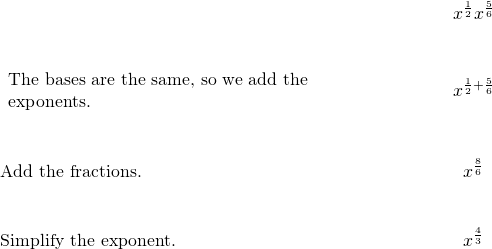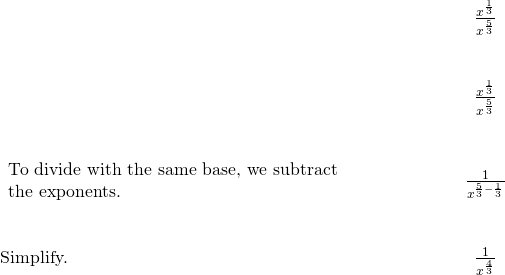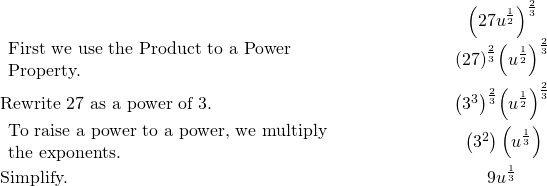58 Simplify Rational Exponents
Learning Objectives
By the end of this section, you will be able to:
- Simplify expressions with

- Simplify expressions with

- Use the properties of exponents to simplify expressions with rational exponents
Before you get started, take this readiness quiz.
Simplify Expressions with 
Rational exponents are another way of writing expressions with radicals. When we use rational exponents, we can apply the properties of exponents to simplify expressions.
The Power Property for Exponents says that ![]() when m and n are whole numbers. Let’s assume we are now not limited to whole numbers.
when m and n are whole numbers. Let’s assume we are now not limited to whole numbers.
Suppose we want to find a number p such that ![]() We will use the Power Property of Exponents to find the value of p.
We will use the Power Property of Exponents to find the value of p.

So ![]() But we know also
But we know also ![]() Then it must be that
Then it must be that ![]()
This same logic can be used for any positive integer exponent n to show that ![]()
If ![]() is a real number and
is a real number and ![]() then
then
The denominator of the rational exponent is the index of the radical.
There will be times when working with expressions will be easier if you use rational exponents and times when it will be easier if you use radicals. In the first few examples, you’ll practice converting expressions between these two notations.
Write as a radical expression: ⓐ ![]() ⓑ
ⓑ ![]() ⓒ
ⓒ ![]()
We want to write each expression in the form ![]()
ⓐ

ⓑ
![Rendered by QuickLaTeX.com \begin{array}{cccc}& & & \hfill \phantom{\rule{7em}{0ex}}{y}^{\frac{1}{3}}\hfill \\ \begin{array}{c}\text{The denominator of the exponent is 3, so the}\hfill \\ \text{index is 3.}\hfill \end{array}\hfill & & & \hfill \phantom{\rule{7em}{0ex}}\sqrt[3]{y}\hfill \end{array}](https://pressbooks.bccampus.ca/jkdcintermediatealgebracloned/wp-content/ql-cache/quicklatex.com-8d8d272881eef66861251956a241b3c8_l3.png)
ⓒ
![Rendered by QuickLaTeX.com \begin{array}{cccc}& & & \hfill \phantom{\rule{7em}{0ex}}{z}^{\frac{1}{4}}\hfill \\ \begin{array}{c}\text{The denominator of the exponent is 4, so the}\hfill \\ \text{index is 4.}\hfill \end{array}\hfill & & & \hfill \phantom{\rule{7em}{0ex}}\sqrt[4]{z}\hfill \end{array}](https://pressbooks.bccampus.ca/jkdcintermediatealgebracloned/wp-content/ql-cache/quicklatex.com-14f4579437eee56684179063e006ab12_l3.png)
Write as a radical expression: ⓐ ![]() ⓑ
ⓑ ![]() ⓒ
ⓒ ![]()
ⓐ![]() ⓑ
ⓑ![]() ⓒ
ⓒ![]()
Write as a radial expression: ⓐ ![]() ⓑ
ⓑ ![]() ⓒ
ⓒ ![]()
ⓐ![]() ⓑ
ⓑ![]() ⓒ
ⓒ![]()
In the next example, we will write each radical using a rational exponent. It is important to use parentheses around the entire expression in the radicand since the entire expression is raised to the rational power.
Write with a rational exponent: ⓐ ![]() ⓑ
ⓑ ![]() ⓒ
ⓒ ![]()
We want to write each radical in the form ![]()
ⓐ

ⓑ
*** QuickLaTeX cannot compile formula:
\begin{array}{cccc}& & & \hfill \phantom{\rule{5em}{0ex}}\sqrt[3]{4x}\hfill \\ \begin{array}{c}\text{The index is 3, so the denominator of the}\hfill \\ \text{exponent is 3. Include parentheses}\phantom{\rule{0.2em}{0ex}}\left(4x\right).\hfill \end{array}\hfill & & & \hfill \begin{array}{}\\ \\ \hfill \phantom{\rule{5em}{0ex}}{\left(4x\right)}^{\frac{1}{3}}\hfill \end{array}\hfill \end{array}
*** Error message:
Missing # inserted in alignment preamble.
leading text: ...d{array}\hfill & & & \hfill \begin{array}{}
Missing $ inserted.
leading text: ...\ \\ \hfill \phantom{\rule{5em}{0ex}}{\left
Extra }, or forgotten $.
leading text: ... \phantom{\rule{5em}{0ex}}{\left(4x\right)}
Missing } inserted.
leading text: ...(4x\right)}^{\frac{1}{3}}\hfill \end{array}
Extra }, or forgotten $.
leading text: ...(4x\right)}^{\frac{1}{3}}\hfill \end{array}
Missing } inserted.
leading text: ...(4x\right)}^{\frac{1}{3}}\hfill \end{array}
Extra }, or forgotten $.
leading text: ...(4x\right)}^{\frac{1}{3}}\hfill \end{array}
Missing } inserted.
leading text: ...(4x\right)}^{\frac{1}{3}}\hfill \end{array}
Extra }, or forgotten $.
leading text: ...(4x\right)}^{\frac{1}{3}}\hfill \end{array}
ⓒ
*** QuickLaTeX cannot compile formula:
\begin{array}{cccc}& & & \hfill \phantom{\rule{4em}{0ex}}3\phantom{\rule{0.2em}{0ex}}\sqrt[4]{5z}\hfill \\ \begin{array}{c}\text{The index is 4, so the denominator of the}\hfill \\ \text{exponent is 4. Put parentheses only around}\hfill \\ \text{the}\phantom{\rule{0.2em}{0ex}}5z\phantom{\rule{0.2em}{0ex}}\text{since 3 is not under the radical sign.}\hfill \end{array}\hfill & & & \hfill \begin{array}{}\\ \\ \\ \\ \hfill \phantom{\rule{4em}{0ex}}3{\left(5z\right)}^{\frac{1}{4}}\hfill \end{array}\hfill \end{array}
*** Error message:
Missing # inserted in alignment preamble.
leading text: ...d{array}\hfill & & & \hfill \begin{array}{}
Missing $ inserted.
leading text: ... \\ \hfill \phantom{\rule{4em}{0ex}}3{\left
Extra }, or forgotten $.
leading text: ...\phantom{\rule{4em}{0ex}}3{\left(5z\right)}
Missing } inserted.
leading text: ...(5z\right)}^{\frac{1}{4}}\hfill \end{array}
Extra }, or forgotten $.
leading text: ...(5z\right)}^{\frac{1}{4}}\hfill \end{array}
Missing } inserted.
leading text: ...(5z\right)}^{\frac{1}{4}}\hfill \end{array}
Extra }, or forgotten $.
leading text: ...(5z\right)}^{\frac{1}{4}}\hfill \end{array}
Missing } inserted.
leading text: ...(5z\right)}^{\frac{1}{4}}\hfill \end{array}
Extra }, or forgotten $.
leading text: ...(5z\right)}^{\frac{1}{4}}\hfill \end{array}
Write with a rational exponent: ⓐ ![]() ⓑ
ⓑ ![]() ⓒ
ⓒ ![]()
ⓐ![]() ⓑ
ⓑ![]()
ⓒ![]()
Write with a rational exponent: ⓐ ![]() ⓑ
ⓑ ![]() ⓒ
ⓒ ![]()
ⓐ![]() ⓑ
ⓑ![]()
ⓒ![]()
In the next example, you may find it easier to simplify the expressions if you rewrite them as radicals first.
Simplify: ⓐ ![]() ⓑ
ⓑ ![]() ⓒ
ⓒ ![]()
ⓐ

ⓑ
![Rendered by QuickLaTeX.com \begin{array}{cccc}& & & \hfill \phantom{\rule{8.5em}{0ex}}{64}^{\frac{1}{3}}\hfill \\ \text{Rewrite as a cube root.}\hfill & & & \hfill \phantom{\rule{8.5em}{0ex}}\sqrt[3]{64}\hfill \\ \text{Recognize 64 is a perfect cube.}\hfill & & & \hfill \phantom{\rule{8.5em}{0ex}}\sqrt[3]{{4}^{3}}\hfill \\ \text{Simplify.}\hfill & & & \hfill \phantom{\rule{8.5em}{0ex}}4\hfill \end{array}](https://pressbooks.bccampus.ca/jkdcintermediatealgebracloned/wp-content/ql-cache/quicklatex.com-bc7edca1d8a5038e991d79df592e2460_l3.png)
ⓒ
![Rendered by QuickLaTeX.com \begin{array}{cccc}& & & \hfill \phantom{\rule{4em}{0ex}}{256}^{\frac{1}{4}}\hfill \\ \text{Rewrite as a fourth root.}\hfill & & & \hfill \phantom{\rule{4em}{0ex}}\sqrt[4]{256}\hfill \\ \text{Recognize 256 is a perfect fourth power.}\hfill & & & \hfill \phantom{\rule{4em}{0ex}}\sqrt[4]{{4}^{4}}\hfill \\ \text{Simplify.}\hfill & & & \hfill \phantom{\rule{4em}{0ex}}4\hfill \end{array}](https://pressbooks.bccampus.ca/jkdcintermediatealgebracloned/wp-content/ql-cache/quicklatex.com-618a9f8b9541fe2edda2a728acee5f1e_l3.png)
Simplify: ⓐ ![]() ⓑ
ⓑ ![]() ⓒ
ⓒ ![]()
ⓐ 6 ⓑ 2 ⓒ 2
Simplify: ⓐ ![]() ⓑ
ⓑ ![]() ⓒ
ⓒ ![]()
ⓐ 10 ⓑ 3 ⓒ 3
Be careful of the placement of the negative signs in the next example. We will need to use the property ![]() in one case.
in one case.
Simplify: ⓐ ![]() ⓑ
ⓑ ![]() ⓒ
ⓒ ![]()
ⓐ
![Rendered by QuickLaTeX.com \begin{array}{cccc}& & & \hfill \phantom{\rule{9em}{0ex}}{\left(-16\right)}^{\frac{1}{4}}\hfill \\ \text{Rewrite as a fourth root.}\hfill & & & \hfill \phantom{\rule{9em}{0ex}}\sqrt[4]{-16}\hfill \\ & & & \hfill \phantom{\rule{9em}{0ex}}\sqrt[4]{{\left(-2\right)}^{4}}\hfill \\ \text{Simplify.}\hfill & & & \hfill \phantom{\rule{9em}{0ex}}\text{No real solution.}\hfill \end{array}](https://pressbooks.bccampus.ca/jkdcintermediatealgebracloned/wp-content/ql-cache/quicklatex.com-a7778e914837853e5ba1ed6817122eab_l3.png)
ⓑ
![Rendered by QuickLaTeX.com \begin{array}{cccc}& & & \hfill \phantom{\rule{5.5em}{0ex}}\text{−}{16}^{\frac{1}{4}}\hfill \\ \begin{array}{c}\text{The exponent only applies to the 16.}\hfill \\ \text{Rewrite as a fouth root.}\hfill \end{array}\hfill & & & \hfill \phantom{\rule{5.5em}{0ex}}\text{−}\sqrt[4]{16}\hfill \\ \text{Rewrite 16 as}\phantom{\rule{0.2em}{0ex}}{2}^{4}.\hfill & & & \hfill \phantom{\rule{5.5em}{0ex}}\text{−}\sqrt[4]{{2}^{4}}\hfill \\ \text{Simplify.}\hfill & & & \hfill \phantom{\rule{5.5em}{0ex}}-2\hfill \end{array}](https://pressbooks.bccampus.ca/jkdcintermediatealgebracloned/wp-content/ql-cache/quicklatex.com-c786b2f60048c317cf832011d66a7134_l3.png)
ⓒ
![Rendered by QuickLaTeX.com \begin{array}{cccc}& & & \hfill \phantom{\rule{4.5em}{0ex}}{\left(16\right)}^{-\frac{1}{4}}\hfill \\ \text{Rewrite using the property}\phantom{\rule{0.2em}{0ex}}{a}^{\text{−}n}=\frac{1}{{a}^{n}}.\hfill & & & \hfill \phantom{\rule{4.5em}{0ex}}\frac{1}{{\left(16\right)}^{\frac{1}{4}}}\hfill \\ \text{Rewrite as a fourth root.}\hfill & & & \hfill \phantom{\rule{4.5em}{0ex}}\frac{1}{\sqrt[4]{16}}\hfill \\ \text{Rewrite 16 as}\phantom{\rule{0.2em}{0ex}}{2}^{4}.\hfill & & & \hfill \phantom{\rule{4.5em}{0ex}}\frac{1}{\sqrt[4]{{2}^{4}}}\hfill \\ \text{Simplify.}\hfill & & & \hfill \phantom{\rule{4.5em}{0ex}}\frac{1}{2}\hfill \end{array}](https://pressbooks.bccampus.ca/jkdcintermediatealgebracloned/wp-content/ql-cache/quicklatex.com-acd48df40cf7b1778b0eea9ba47b8e0c_l3.png)
Simplify: ⓐ ![]() ⓑ
ⓑ ![]() ⓒ
ⓒ ![]()
ⓐ No real solution ⓑ ![]()
ⓒ ![]()
Simplify: ⓐ ![]() ⓑ
ⓑ ![]() ⓒ
ⓒ ![]()
ⓐ No real solution ⓑ ![]()
ⓒ ![]()
Simplify Expressions with 
We can look at ![]() in two ways. Remember the Power Property tells us to multiply the exponents and so
in two ways. Remember the Power Property tells us to multiply the exponents and so ![]() and
and ![]() both equal
both equal ![]() If we write these expressions in radical form, we get
If we write these expressions in radical form, we get
This leads us to the following definition.
For any positive integers m and n,
Which form do we use to simplify an expression? We usually take the root first—that way we keep the numbers in the radicand smaller, before raising it to the power indicated.
Write with a rational exponent: ⓐ ![]() ⓑ
ⓑ ![]() ⓒ
ⓒ ![]()
We want to use ![]() to write each radical in the form
to write each radical in the form ![]()
ⓐ
 |
ⓑ
 |
ⓒ
 |
Write with a rational exponent: ⓐ ![]() ⓑ
ⓑ ![]() ⓒ
ⓒ ![]()
ⓐ![]() ⓑ
ⓑ![]() ⓒ
ⓒ![]()
Write with a rational exponent: ⓐ ![]() ⓑ
ⓑ ![]() ⓒ
ⓒ ![]()
ⓐ![]() ⓑ
ⓑ![]()
ⓒ![]()
Remember that ![]() The negative sign in the exponent does not change the sign of the expression.
The negative sign in the exponent does not change the sign of the expression.
Simplify: ⓐ ![]() ⓑ
ⓑ ![]() ⓒ
ⓒ ![]()
We will rewrite the expression as a radical first using the defintion, ![]() This form lets us take the root first and so we keep the numbers in the radicand smaller than if we used the other form.
This form lets us take the root first and so we keep the numbers in the radicand smaller than if we used the other form.
ⓐ
![Rendered by QuickLaTeX.com \begin{array}{cccc}& & & \hfill \phantom{\rule{4em}{0ex}}{125}^{\frac{2}{3}}\hfill \\ \begin{array}{c}\text{The power of the radical is the numerator of the exponent, 2.}\hfill \\ \text{The index of the radical is the denominator of the}\hfill \\ \text{exponent, 3.}\hfill \end{array}\hfill & & & \hfill \phantom{\rule{4em}{0ex}}{\left(\sqrt[3]{125}\right)}^{2}\hfill \\ \text{Simplify.}\hfill & & & \hfill \phantom{\rule{4em}{0ex}}{\left(5\right)}^{2}\hfill \\ & & & \hfill \phantom{\rule{4em}{0ex}}25\hfill \end{array}](https://pressbooks.bccampus.ca/jkdcintermediatealgebracloned/wp-content/ql-cache/quicklatex.com-0e2d999c4237b700120f8208400f3ac0_l3.png)
ⓑ We will rewrite each expression first using ![]() and then change to radical form.
and then change to radical form.

ⓒ
![Rendered by QuickLaTeX.com \begin{array}{cccc}& & & \hfill \phantom{\rule{15em}{0ex}}{32}^{-\frac{2}{5}}\hfill \\ \\ \\ \text{Rewrite using}\phantom{\rule{0.2em}{0ex}}{a}^{\text{−}n}=\frac{1}{{a}^{n}}.\hfill & & & \hfill \phantom{\rule{15em}{0ex}}\frac{1}{{32}^{\frac{2}{5}}}\hfill \\ \\ \\ \text{Change to radical form.}\hfill & & & \hfill \phantom{\rule{15em}{0ex}}\frac{1}{{\left(\sqrt[5]{32}\right)}^{2}}\hfill \\ \\ \\ \text{Rewrite the radicand as a power.}\hfill & & & \hfill \phantom{\rule{15em}{0ex}}\frac{1}{{\left(\sqrt[5]{{2}^{5}}\right)}^{2}}\hfill \\ \\ \\ \text{Simplify.}\hfill & & & \hfill \phantom{\rule{15em}{0ex}}\frac{1}{{2}^{2}}\hfill \\ \\ \\ & & & \hfill \phantom{\rule{15em}{0ex}}\frac{1}{4}\hfill \end{array}](https://pressbooks.bccampus.ca/jkdcintermediatealgebracloned/wp-content/ql-cache/quicklatex.com-ba2dd1b7e5246fead143eb5a8e6e2347_l3.png)
Simplify: ⓐ ![]() ⓑ
ⓑ ![]() ⓒ
ⓒ ![]()
ⓐ 9 ⓑ ![]() ⓒ
ⓒ ![]()
Simplify: ⓐ ![]() ⓑ
ⓑ ![]() ⓒ
ⓒ ![]()
ⓐ 8 ⓑ ![]() ⓒ
ⓒ ![]()
Simplify: ⓐ ![]() ⓑ
ⓑ ![]() ⓒ
ⓒ ![]()
ⓐ

ⓑ

ⓒ

Simplify: ⓐ ![]() ⓑ
ⓑ ![]() ⓒ
ⓒ ![]()
ⓐ![]() ⓑ
ⓑ![]() ⓒ not a real number
ⓒ not a real number
Simplify: ⓐ ![]() ⓑ
ⓑ ![]() ⓒ
ⓒ ![]()
ⓐ![]() ⓑ
ⓑ![]() ⓒ not a real number
ⓒ not a real number
Use the Properties of Exponents to Simplify Expressions with Rational Exponents
The same properties of exponents that we have already used also apply to rational exponents. We will list the Properties of Exponenets here to have them for reference as we simplify expressions.
If a and b are real numbers and m and n are rational numbers, then

We will apply these properties in the next example.
Simplify: ⓐ ![]() ⓑ
ⓑ ![]() ⓒ
ⓒ ![]()
ⓐ The Product Property tells us that when we multiply the same base, we add the exponents.

ⓑ The Power Property tells us that when we raise a power to a power, we multiply the exponents.

ⓒ The Quotient Property tells us that when we divide with the same base, we subtract the exponents.

Simplify: ⓐ ![]() ⓑ
ⓑ ![]() ⓒ
ⓒ ![]()
ⓐ![]() ⓑ
ⓑ![]() ⓒ
ⓒ![]()
Simplify: ⓐ ![]() ⓑ
ⓑ ![]() ⓒ
ⓒ ![]()
ⓐ![]() ⓑ
ⓑ![]() ⓒ
ⓒ![]()
Sometimes we need to use more than one property. In the next example, we will use both the Product to a Power Property and then the Power Property.
Simplify: ⓐ ![]() ⓑ
ⓑ ![]()
ⓐ

ⓑ

Simplify: ⓐ ![]() ⓑ
ⓑ ![]()
ⓐ![]() ⓑ
ⓑ![]()
Simplify: ⓐ ![]() ⓑ
ⓑ ![]()
ⓐ![]() ⓑ
ⓑ![]()
We will use both the Product Property and the Quotient Property in the next example.
Simplify: ⓐ ![]() ⓑ
ⓑ ![]()
ⓐ

ⓑ Follow the order of operations to simplify inside the parenthese first.

Simplify: ⓐ ![]() ⓑ
ⓑ ![]()
ⓐ![]() ⓑ
ⓑ![]()
Simplify: ⓐ ![]() ⓑ
ⓑ ![]()
ⓐ![]() ⓑ
ⓑ![]()
Access these online resources for additional instruction and practice with simplifying rational exponents.
Key Concepts
- Rational Exponent

- If
![Rendered by QuickLaTeX.com \sqrt[n]{a}](https://pressbooks.bccampus.ca/jkdcintermediatealgebracloned/wp-content/ql-cache/quicklatex.com-1c6b7326bec5fc086e8335bb7e382f30_l3.png) is a real number and
is a real number and  then
then ![Rendered by QuickLaTeX.com {a}^{\frac{1}{n}}=\sqrt[n]{a}.](https://pressbooks.bccampus.ca/jkdcintermediatealgebracloned/wp-content/ql-cache/quicklatex.com-0f05ebbed67aa5e0fb1c892cd420dbb9_l3.png)
- If
- Rational Exponent

- For any positive integers m and n,
![Rendered by QuickLaTeX.com {a}^{\frac{m}{n}}={\left(\sqrt[n]{a}\right)}^{m}](https://pressbooks.bccampus.ca/jkdcintermediatealgebracloned/wp-content/ql-cache/quicklatex.com-62360377a0c280d6b05c40df3183fde4_l3.png) and
and ![Rendered by QuickLaTeX.com {a}^{\frac{m}{n}}=\sqrt[n]{{a}^{m}}](https://pressbooks.bccampus.ca/jkdcintermediatealgebracloned/wp-content/ql-cache/quicklatex.com-92a59fa5e344ddb471907ec777535f53_l3.png)
- For any positive integers m and n,
- Properties of Exponents
- If a, b are real numbers and m, n are rational numbers, then
- Product Property

- Power Property

- Product to a Power

- Quotient Property

- Zero Exponent Definition


- Quotient to a Power Property

- Negative Exponent Property

- Product Property
- If a, b are real numbers and m, n are rational numbers, then
Practice Makes Perfect
Simplify expressions with ![]()
In the following exercises, write as a radical expression.
ⓐ![]() ⓑ
ⓑ![]() ⓒ
ⓒ![]()
ⓐ![]() ⓑ
ⓑ![]() ⓒ
ⓒ![]()
ⓐ![]() ⓑ
ⓑ![]() ⓒ
ⓒ![]()
ⓐ![]() ⓑ
ⓑ![]() ⓒ
ⓒ![]()
ⓐ![]() ⓑ
ⓑ![]() ⓒ
ⓒ![]()
ⓐ![]() ⓑ
ⓑ![]() ⓒ
ⓒ![]()
In the following exercises, write with a rational exponent.
ⓐ![]() ⓑ
ⓑ![]() ⓒ
ⓒ![]()
ⓐ![]() ⓑ
ⓑ![]() ⓒ
ⓒ![]()
ⓐ![]() ⓑ
ⓑ![]() ⓒ
ⓒ![]()
ⓐ![]() ⓑ
ⓑ![]() ⓒ
ⓒ![]()
ⓐ![]() ⓑ
ⓑ![]()
ⓒ![]()
ⓐ![]() ⓑ
ⓑ![]() ⓒ
ⓒ![]()
ⓐ![]() ⓑ
ⓑ![]() ⓒ
ⓒ![]()
ⓐ![]() ⓑ
ⓑ![]()
ⓒ![]()
ⓐ![]() ⓑ
ⓑ![]() ⓒ
ⓒ![]()
In the following exercises, simplify.
ⓐ![]()
ⓑ![]()
ⓒ![]()
ⓐ 9 ⓑ 5 ⓒ 8
ⓐ![]()
ⓑ![]()
ⓒ![]()
ⓐ![]()
ⓑ![]()
ⓒ![]()
ⓐ 2 ⓑ 4 ⓒ 5
ⓐ![]()
ⓑ![]()
ⓒ![]()
ⓐ![]()
ⓑ![]()
ⓒ![]()
ⓐ![]() ⓑ
ⓑ![]() ⓒ
ⓒ![]()
ⓐ![]()
ⓑ![]()
ⓒ![]()
ⓐ![]()
ⓑ![]()
ⓒ![]()
ⓐ not real ⓑ ![]() ⓒ
ⓒ ![]()
ⓐ![]()
ⓑ![]()
ⓒ![]()
ⓐ![]()
ⓑ![]()
ⓒ![]()
ⓐ not real ⓑ ![]() ⓒ
ⓒ ![]()
ⓐ![]()
ⓑ![]()
ⓒ![]()
ⓐ![]()
ⓑ![]()
ⓒ![]()
ⓐ not real ⓑ ![]() ⓒ
ⓒ ![]()
ⓐ![]()
ⓑ![]()
ⓒ![]()
Simplify Expressions with ![]()
In the following exercises, write with a rational exponent.
ⓐ![]()
ⓑ![]()
ⓒ![]()
ⓐ![]() ⓑ
ⓑ![]() ⓒ
ⓒ![]()
ⓐ![]()
ⓑ![]()
ⓒ![]()
ⓐ![]()
ⓑ![]()
ⓒ![]()
ⓐ![]() ⓑ
ⓑ![]() ⓒ
ⓒ![]()
ⓐ![]()
ⓑ![]()
ⓒ![]()
In the following exercises, simplify.
ⓐ![]()
ⓑ![]()
ⓒ![]()
ⓐ 32,768 ⓑ ![]() ⓒ 9
ⓒ 9
ⓐ![]()
ⓑ![]()
ⓒ![]()
ⓐ![]()
ⓑ![]()
ⓒ![]()
ⓐ 4 ⓑ ![]() ⓒ not real
ⓒ not real
ⓐ![]()
ⓑ![]()
ⓒ![]()
ⓐ![]()
ⓑ![]()
ⓒ![]()
ⓐ![]() ⓑ
ⓑ![]() ⓒ not real
ⓒ not real
ⓐ![]()
ⓑ![]()
ⓒ![]()
Use the Laws of Exponents to Simplify Expressions with Rational Exponents
In the following exercises, simplify. Assume all variables are positive.
ⓐ![]()
ⓑ![]()
ⓒ![]()
ⓐ![]() ⓑ
ⓑ![]() ⓒ
ⓒ![]()
ⓐ![]()
ⓑ![]()
ⓒ![]()
ⓐ![]()
ⓑ![]()
ⓒ![]()
ⓐ![]() ⓑ
ⓑ![]() ⓒ
ⓒ![]()
ⓐ![]()
ⓑ![]()
ⓒ![]()
ⓐ![]()
ⓑ![]()
ⓐ![]() ⓑ
ⓑ![]()
ⓐ![]()
ⓑ![]()
ⓐ![]()
ⓑ![]()
ⓐ![]() ⓑ
ⓑ![]()
ⓐ![]()
ⓑ![]()
ⓐ![]()
ⓑ![]()
ⓐ![]() ⓑ
ⓑ![]()
ⓐ![]()
ⓑ![]()
ⓐ![]()
ⓑ![]()
ⓐ![]() ⓑ
ⓑ![]()
ⓐ![]()
ⓑ![]()
Writing Exercises
Show two different algebraic methods to simplify ![]() Explain all your steps.
Explain all your steps.
Answers will vary.
Explain why the expression ![]() cannot be evaluated.
cannot be evaluated.
Self Check
ⓐ After completing the exercises, use this checklist to evaluate your mastery of the objectives of this section.

ⓑ What does this checklist tell you about your mastery of this section? What steps will you take to improve?

